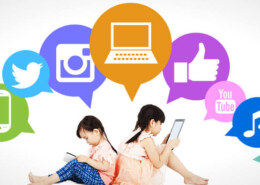Children’s use of technology and social media is a topic of significant concern and interest. Here are some key points to consider:
1. Early Exposure of Children to The Use Of Technology and Social Media:
Many children today are exposed to technology and social media at a very young age, often before they can fully understand the implications.
Early exposure of children to technology and social media is a growing concern. While technology can offer educational and developmental benefits, there are potential risks associated with introducing it to young children.
Importance of Early Exposure:
Educational Tools: Technology can provide educational apps and games that help children learn and develop essential skills, such as language, math, and problem-solving.
Creativity: Some digital tools encourage creativity and exploration, allowing children to express themselves through art, music, and storytelling.
Connectivity: Technology can help children connect with friends and family, especially when physical distances are a factor.
Early Digital Literacy: Early exposure can teach children basic digital literacy skills, which are increasingly important in today’s world.
Risks of Early Exposure:
Developmental Concerns: Excessive screen time at a young age may impact a child’s physical and cognitive development, such as language skills and fine motor skills.
Health Issues: Prolonged screen time can contribute to physical health problems, like obesity, poor posture, and sleep disturbances.
Online Safety: Young children may not fully understand the risks of sharing personal information online or encountering inappropriate content.
Addiction: There’s a concern that children can become addicted to screens and may have difficulty disengaging from technology.
Guidelines for Early Exposure:
Limit Screen Time: The American Academy of Pediatrics recommends limiting screen time for children under 2 and ensuring that it’s high-quality content. For older children, setting reasonable time limits is essential.
Co-View and Co-Play: Parents should co-view and co-play with their children when they use technology to guide their experiences and facilitate learning.
Privacy and Safety: Teach children about online privacy, and use parental controls to ensure safe browsing.
Balance: Encourage a balanced lifestyle that includes physical activity, face-to-face interactions, and outdoor play.
Model Good Behavior: Parents should model responsible and balanced technology use themselves.
2. Benefits of Children’s Use Of Technology and Social Media.
Technology can be educational and provide various opportunities for learning and skill development. It can also help children connect with friends and family. the following are some of the benefits of children’s use of technology and social media.
Educational Opportunities: Technology provides access to a wealth of educational resources, apps, and websites that can support learning in various subjects. Interactive educational games can make learning fun and engaging.
Skill Development: Technology can help children develop important skills, including digital literacy, problem-solving, creativity, and critical thinking.
Global Awareness: Exposure to technology and social media can broaden children’s horizons and expose them to diverse cultures, ideas, and perspectives from around the world.
Creativity and Expression: Digital tools, such as drawing apps and video editing software, allow children to express themselves creatively and explore their artistic talents.
Preparation for the Digital World: In today’s increasingly digital world, familiarity with technology is an asset. Learning how to navigate online spaces and use digital tools responsibly is a valuable life skill.
Access to Information: Technology provides easy access to information, which can be particularly useful for school projects and research.
Problem-Solving and Critical Thinking: Playing certain video games can enhance problem-solving and critical thinking skills, as they often require strategic planning and decision-making.
3. Risks of Children’s Use of Technology and Social Media
Children’s use of technology and social media comes with various risks and challenges that need to be carefully addressed:
Online Safety: Children can encounter online predators and inappropriate content, posing risks to their safety and well-being.
Cyber Bullying: Bullying can occur through social media, messaging apps, or online gaming platforms, leading to emotional distress and psychological harm.
Privacy Concerns: Children may not fully understand the importance of protecting their personal information online, making them vulnerable to privacy breaches.
Excessive Screen Time: Overuse of technology can lead to physical health issues, sleep disturbances, and decreased physical activity, contributing to conditions like childhood obesity.
Mental Health Issues: Excessive screen time has been linked to mental health problems such as depression and anxiety in children
Inappropriate Content: Children might stumble upon age-inappropriate content, including violence, explicit material, or harmful ideologies.
Reduced Face-to-Face Social Interaction: Spending too much time online can limit face-to-face social interactions, which are essential for developing interpersonal skills.
Misinformation and Fake News: Children can struggle to discern credible information from fake news and misinformation when using social media and the internet.
Summary:
Balancing the benefits and risks of technology and social media for children is an ongoing challenge. It requires a combination of responsible parenting, education, and societal awareness to ensure that children’s digital experiences are safe and constructive. Early exposure to technology and social media can have both positive and negative effects on children. The key is to find a balanced approach that harnesses the benefits of technology while mitigating the potential risks through parental guidance, responsible usage, and age-appropriate content.

